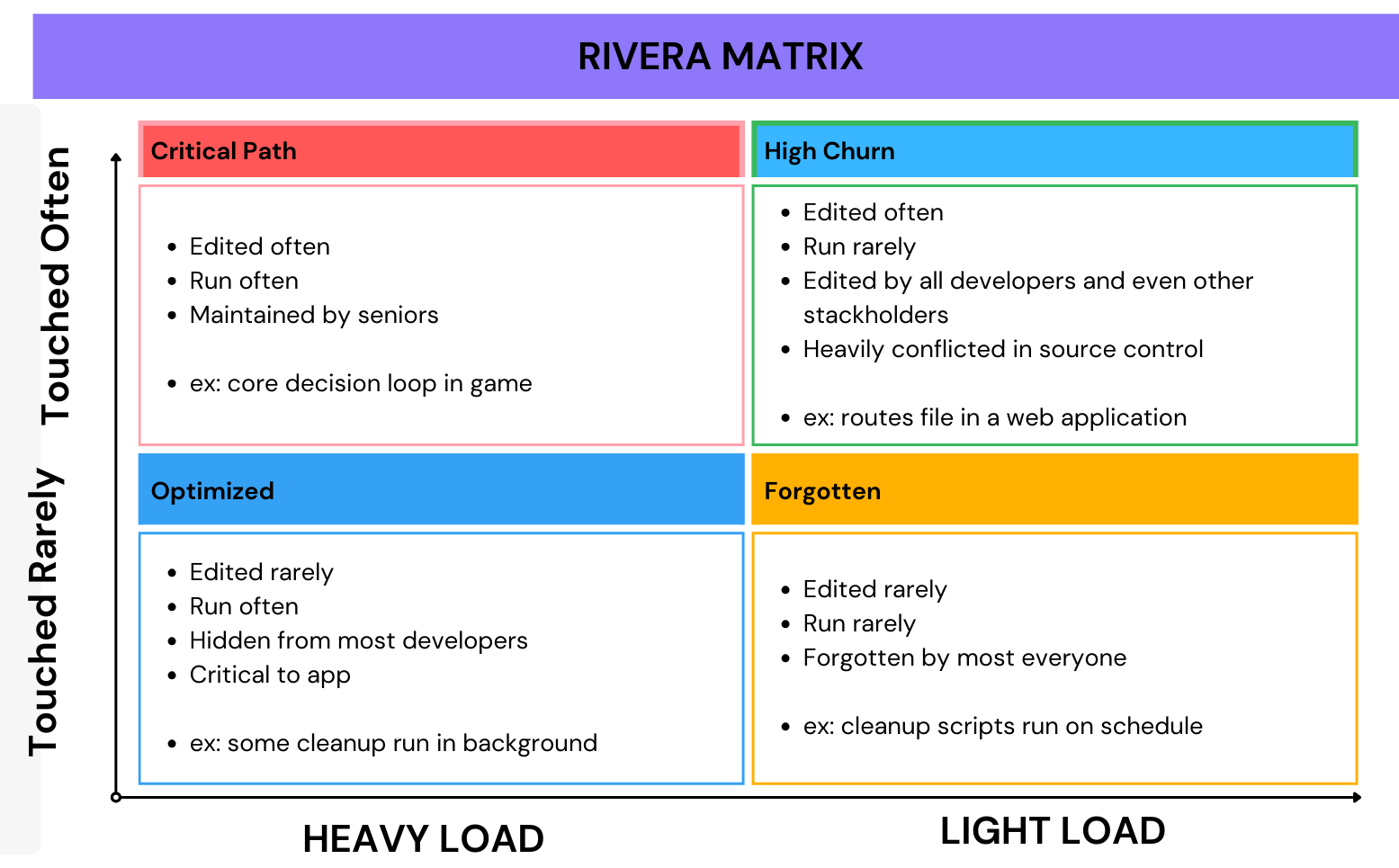The Melton-Rivera Matrix (MRM): A No-Nonsense Guide to Prioritizing Your Coding Efforts
Listen up, folks! In the wild west of coding, where every decision can make or break your project, you need a trusty compass to navigate the chaos. Enter the Melton-Rivera Matrix, a no-nonsense tool that’ll help you prioritize your coding tasks like a boss. This ain’t your grandma’s Eisenhower Matrix; this is the real deal, tailored for the nitty-gritty of software development.
Dreamed up by a late night discussion between myself and Henry Rivera discussing prioritization at Digital Turbine, this matrix is your secret weapon for deciding what to tackle first and how to allocate your coding superheroes.

Quadrant 1: Critical Path
This is where the magic happens, folks. Code in this quadrant is the star of the show, getting all the attention from users and the system alike. It’s the VIP section of your codebase, and it demands nothing but the best. You need your A-team on this, the seasoned vets who can write code that’s faster than a speeding bullet and clearer than a crystal ball. We’re talking meticulous comments, comprehensive docs, and tests so rigorous they’d make a drill sergeant proud. This is the frontline of your software, and there’s no room for rookies here.
Quadrant 2: High Churn
Welcome to the land of code that’s always in the limelight but doesn’t quite break a sweat in the system. This is where you want your master explainers, the ones who can write code so clear, even a junior dev can read it like a bedtime story. Think of it as the educational wing of your codebase, where newbies come to learn and stakeholders come to marvel at your team’s brilliance. Documentation should be so comprehensive, it’s practically a novel, and user guides so friendly, they’re practically holding hands with the reader.
Quadrant 3: Optimized
In this corner of the matrix, it’s all about speed, baby. Performance is king, and efficiency is the name of the game. Your code warriors need to be masters of streamlining, writing functions so fast, they’d leave The Flash in the dust. But it’s not just about writing slick code; you need to put it through the wringer with automated performance tests. We’re talking stress tests that’d make a Navy SEAL sweat, ensuring your system can handle whatever load is thrown its way. Human readability? That’s a luxury we can’t afford here. It’s all about making that code sing.
Quadrant 4: Forgotten
Ah, the forgotten lands of the codebase. The place where code goes to die, but not on our watch! In this quadrant, automated tests are your best friend, the silent guardians that keep the darkness at bay. Your mission, should you choose to accept it, is to write tests so comprehensive, they’d catch a bug in a haystack. Documentation is still important, but it plays a supporting role here. Think of it as the trusty sidekick to your automated testing superhero, ensuring that even the most neglected code stays sharp and ready for action.
Development and Bug Fixing Order
But wait, there’s more! The Melton-Rivera Matrix isn’t just about categorizing your code; it’s about knowing what to tackle first. Here’s your marching order:
- Quadrant 1 (Critical Path): This is your ground zero, folks. Any issues or improvements here will have the biggest impact, so start with this quadrant and don’t look back.
- Quadrant 2 (High Churn): Next up, focus on the code that’s always in the spotlight. Keep it clear, keep it functional, and keep your team and stakeholders happy.
- Quadrant 3 (Optimized): Now it’s time to put the pedal to the metal. Dive into this quadrant and make that code sing like a well-oiled machine.
- Quadrant 4 (Forgotten): Last but not least, shine a light on those forgotten corners of your codebase. Hunt down those bugs with automated tests and make sure nothing escapes your notice.
By following this order, you’ll keep your codebase in tip-top shape, running like a well-oiled machine, and ready for anything.
So there you have it, folks. The Melton-Rivera Matrix: your trusty guide through the treacherous terrain of software development. Use it wisely, and may your code be forever bug-free and your coffee forever strong. Now, if you’ll excuse me, I have some critical path code to attend to.